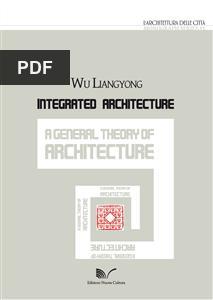Descrizione prodotto
Integrated Architecture is both a historical and contemporary work. The book was fi rst published in 1989 by Wu Liangyong, one of contemporary China’s most infl uential architects and theoreticians with the title A General Theory on Architecture. His eminence is also recognised by the international architectural community, above all, the group of architectural and urban planning theoreticians battling for a more decisive reform to the concepts, methodologies and practices presiding over the construction and requalifi cation of the contemporary metropolis. I fi rst met professor Wu Liangyong in 2005 at the Faculty of Architecture at the Tsinghua University of Beijing; his Faculty. Wu Liangyong founded the school in 1949 – at the age of 24 – together with Liang Sicheng, the father of modern Chinese architectural studies. From this moment – more than sixty-seven years ago – professor Liangyong has remained a central fi gure in Beijing’s academic community. He remains a constant source of inspiration, not only national, to education reforms and, above all, theoretical, methodological and operative research into architecture, the city and the territory. He is a rare fi gure, present throughout a lengthy historical period witness the world over to tumultuous upheavals in society and its cities. A period whose most dramatic and exalting manifestations were perhaps to be found in China; a period of war, of hope, of revolutions, of great leaps forward, of presumptions, horrors, errors, new leaps forward and incomprehensible economic growth; of irreversible social and cultural metamorphoses and – what interests us most as architects – of staggering urban growth and territorial transformations. The intellect of this minute and genteel fi gure held fast against the storms of history. The observation of events and the humanist and scientifi c principles of his personal culture continuously nourished an increasingly more effective refl ection on the meaning of architecture in today’s world. He also clearly saw its inextricable ties to the substance of the city and the impossibility to substitute the fi gure of the architect – scientist, humanist and artist. A few years after our meeting, having absorbed direct lessons from Wu’s work as an architect and theoretician, I proposed an Italian translation of an anthology of his writings. The material was to be drawn from his many books and essays on architecture and the city published continuously over the course of his incomparable career. Professor Wu Liangyong responded with a challenge: in lieu of this anthology of texts he proposed a full translation, in Italian and English, of a book published twenty years ago: 1989’s A General Theory on Architecture. Given the pace of cultural debate it would not have been out of place to imagine a book fi rmly sedimented in history. I understood, instead, that it was a milestone in the expression of Wu Liangyong’s ideas; a benchmark that, in all likelihood, served as the starting point for his later theories, even the most recent. Published in other fundamental essays, they range across the vast fi eld of human settlements, touching on all components of the man-made environment (Lucio Valerio Barbera).
Wu Liangyong, Professor of Architecture, member of the Chinese Academies of Science and Engineering, was born in Nanjing, Jiangsu Province, on May 7, 1922. He graduated in 1944 as a Bachelor of Architecture from the Department of Architecture, National Central University, Chongqing. He worked with Professor Liang Sicheng in founding the Department of Architecture at Tsinghua University after 1946, and engaged in teaching, researching and practicing in the fi elds of architecture, urban planning and designing. He took the seat of Deputy Director and later Director of the Department of Architecture, Vice President of the International Union of Architects, President of the World Society for the Science of Human Settlements, as well as the President of the Urban Planning Society of China, Vice President of the Architectural Society of China, Vice President of the China Society of Urban Studies. He led a team which carried out a study of buildings for the proposed Beijing Olympics and has also been awarded the First Award for Scientifi c and Technological Progress by the State Education Commission. Since 1987, he has been in charge of a research project, Beijing Ju’er Hutong new courtyard house, which has won several awards at the national level, a gold medal by the Asian Architects Regional Council Award for Architecture and a UN World Habitat Award. His book, A General Theory of Architecture, won the 1st prize for Scientifi c and Technological Research Progress from State Education Commission. He was promoted as a National Advanced Worker, won the He-Liang-He-Li Prize in 1995, and received the UIA Architectural Education Prize in 1996.
Foreword by Lucio Valerio Barbera
Translations by Anna Irene Del Monaco, Liu Jian, Ying Jin George Michael Riddel, Roberta Tontini
Afterword by Anna Irene Del Monaco
Titolo: Integrated Architecture
Autore: Liangyong Wu;
Editore: Edizioni Nuova Cultura
Formato PDF con Digital watermarking
ISBN: 9788868123383


Recensioni
Nessuna recensione presente ancora, vuoi inviare la tua?